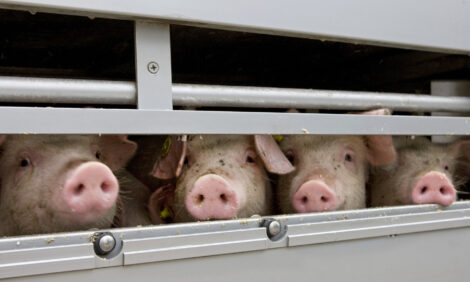



Market Preview: Canada's Breeding Herd Smaller
US - In this week's US Market Preview, published in National Hog Farmer's Weekly Preview, Steve Meyer, Ph.D. of Paragon Economics, Inc., writes about Canada's 1 July pig inventories.Statistics Canada released its estimate of 1 July pig inventories last week, which reflect continuing reductions in Canada’s pork sector. Total inventories amounted to 11.781 million head, 2.4 per cent lower than one year earlier. Canada’s market herd contracted by 2 per cent since last July and stood at 10.476 million head on 1 July 2010. Canada’s breeding herd was 1.305 million head, 5 per cent smaller this year vs. last year.
Figure 1 shows the percentage changes for the United States, Canadian and combined breeding herds. All are still far from returning to year-on-year growth, but the chart does not tell the entire story.

The combined US and Canadian breeding herd on 1 June/1 July was 7.093 million head – 29,200 larger than they were on 1 March/1 April (see Figure 2). Most of that increase was due to an increase of 28,000 head for the US breeding herd, but the Canadian herd actually gained 1,200 head from April to July.

If March/April in fact marks the low point for the Canada-US breeding herd, it would amount to an 8.9 per cent reduction from the high water mark of Sept/Oct ’07, when the combined herd reached 7.752 million head. Over that time period, the US herd has fallen by 7.3 per cent and Canada’s has declined by 15.6 per cent. That is not the full extent of Canada’s liquidation, however, since it actually began back in 2005. Canada’s herd has shrunk by 20 per cent since its peak in January 2005.
Profits and potential profits (see last week’s edition) certainly suggest that we may be seeing a bottom to breeding herds on both sides of the border. However, this does not mean we will see year-over-year increases any time soon. To get back to Sept/Oct ’09 levels, Canada would have to add 35,000 sows this quarter and US producers would have to add 87,000 sows. I would say both are highly unlikely even though we could see some growth in both countries.
Meadowbrook Plant Purchased
The US packing sector will apparently get an infusion of capacity this fall as Trim-Rite, an Illinois-based processor has announced that it will buy the idled Meadowbrook Farms slaughter plant in Rantoul, IL. Trim-Rite has talked about building a slaughter operation for several years but has never pulled the trigger.
The Meadowbrook plant would be a definite expansion for Trim-Rite, which did not indicate any intentions for daily slaughter rate. The company did say they would employ 200 workers, only about one-third as many as Meadowbrook employed when the plant was slaughtering about 3,000 head/day. The plant has a capacity of 3,800 head/day. Although the company did not pinpoint an opening date, they indicated the facility could be up and running in six months.
New Cutout Value Record
In case you missed it, last week’s average USDA pork cutout value set a new record of $93.85 (see Figure 3), thus breaking the old record of $93.75 set the week of 13 August 2008.

The new record was driven by higher values for virtually every wholesale cut. Picnics and hams gained $2.74 and $3.15/cwt., respectively, last week to lead the push to new highs. But the real story was ribs and bellies with Primal Cutout Values at $141.78 and $141.59/cwt. last week. Note that the Primal Cutout Value is an estimate of the value of the “raw wholesale cut” just as it comes off the carcass with only initial trimming. Actual prices as they are sold were $1.55 and $1.46/lb., respectively, for ribs and bellies last week.
One driver of these prices is a very current freezer stock situation for pork (see Figure 3). Stocks of frozen pork are at their lowest level since 2004, and the percentage of monthly production held in freezers is among the lowest levels since 1998, when this measure shifted to, in general, 25-35 per cent. Add tight frozen stocks to sharply lower hog numbers (down 7.1 per cent compared to the same period last year), and we get a recipe for continuing good cash prices and strength in futures markets.










